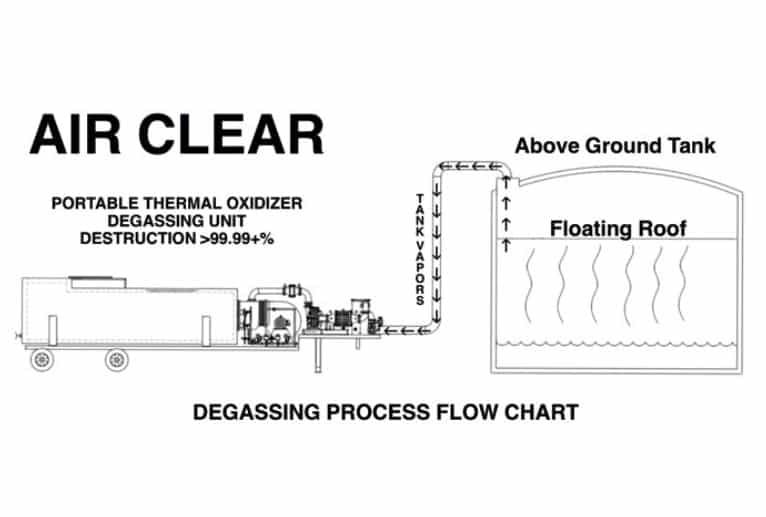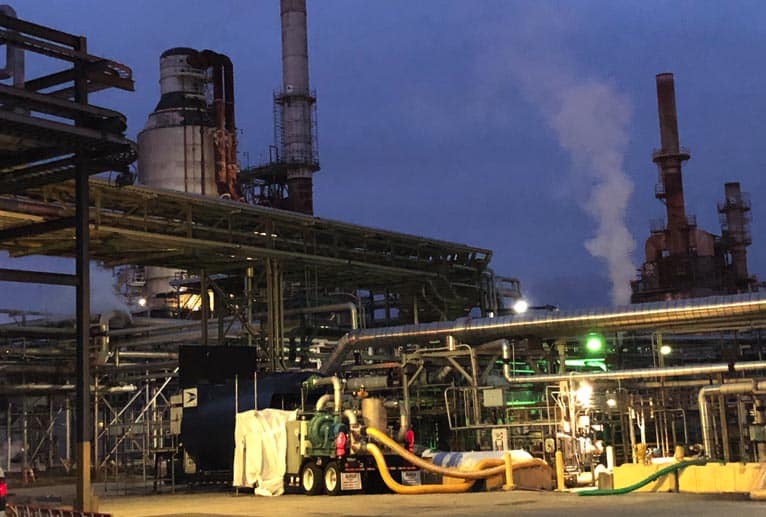Image of an Air Clear Portable Thermal Oxidizer Unit (also known as a Mobile Thermal Oxidizer Unit) on a Tank Vent Process at a Refinery in Philadelphia, PA
An ever-expanding sector in the APC industry is degassing. The degassing process itself can vary from Marine Terminals to Transport Vessels (ex: Rail Cars) and companies with Stationary Tanks & Pipelines that contain volatile organic compounds (VOC’S). The VOCs in the tank represent a large potential environmental/regulatory problem should they be released without the proper VOC controls. That leaves the potential for large amounts of the vapors remaining in the tanks to require treatment via emission control technology to avoid releasing them directly into the atmosphere.
What is Degassing?
’Degassing’ is the removal of hydrocarbons, explosive, odorous, or even noxious vapor from a tank, vessel, or pipeline under pressure/vacuum and controlling that vapor through chemical reactions, typically Oxidation. Oxidation uses high temperatures to convert VOC’s to water vapor and carbon dioxide.
From complex and high flow units that require strict compliance with local and federal government emission regulations to smaller customized units that focus on mobility, the Air Clear Mobile Vapor Control System is the industry choice for vapor and gas control solutions.
How does a typical degassing process work?
- First, the vapors from the tank are extracted out and run into an Air Clear degassing unit. Dilution Air is then put into the tank, which at first is rich (High VOC) enough to be higher than the UEL or (upper explosive limit) before the degassing begins.
- Next, the vapor in the tank gets mixed with the dilution air in special cases (if chemicals like pyrophoric iron or any other ignition sources could be present) then nitrogen is introduced in lieu of dilution air to reduce the potential for an explosion.
- Vapor control is reduced once the roof of the storage tank is floating and all of the vapor space is eliminated
- During a refilling process tank degassing is also commonly used. When liquids that rapidly change from a liquid to vapor at standard conditions are introduced into an empty tank they often flash and vapor is created. As this process continues (more liquid is filled into the tank) then harmful hydrocarbon vapors compress and release into the atmosphere in the form of air emissions. As a result of the air pollution generated during this process, many states require degassing.
- For Internal Tank Inspections the process is similar. Harmful vapors are removed by our Equipment after Nitrogen or Air is introduced.
After removing petrochemicals/VOCs from a stationary pipeline or tank, harmful gas vapors that remain behind need to be removed/treated. This is achieved by the use of a Thermal Oxidizer (TOX). The emissions are drawn into the TOX unit which heats the gases safely to a setpoint temperature (1500 f) where the VOCs & HAPs are then oxidized, transforming them into H2O & CO2. When the process is rich in VOCs then the method is very economical, because those VOCs when ignited release heat that is used to keep the unit at 1500.
The degassing process is accomplished using our proprietary systems with over 3 decades of experience perfecting in the field. Passing along the benefits of our innovations to our clients.

The degassing of a tank can be very dangerous, when performed incorrectly. As the degassing process is performed the tank must go through what is known as the “explosive range” (The range of a concentration of gas or vapor that will explode if an ignition source is introduced). Air Clear overcomes this hurdle by implementing multiphase safety features and gets through the phase as fast as possible. Also training your operators to understand how to safely operate our degassing equipment is a crucial part of that safety.
With 30+ years of experience as a leader in Air Pollution Control Technology, Air Clear is confident that we will help our clients select the safest and most cost-effective solution method for their process. The flow ranges for an Air Clear Mobile TOX Unit range from 1,000 to 6,000 CFM. One note is that flow ranges are based more on heat release capacity of what the unit can handle – 5 million btu/hr. to 60 mm btu/hr. heat release – 150 scfm to 6000 scfm of tank vapor.

Air Clear’s Mobile Thermal Oxidizer Units are designed and manufactured to work around the clock. Our units are easy and convenient to move around the job site with full operational training done by our highly trained service engineering staff.
Pipeline & Tank degassing:
- Prioritizes safety by minimizing the risk of explosions by implementing redundant safety devices
- Eliminates <99.999 of all VOCs & HAPs by neutralizing the hazardous air emissions from degassing
- Protects employees, neighbors, family, and the environment so your business can be more sustainable and your community can continue to grow.
Together with our customers, we develop a degassing plan that safely maximizes the degassing process:
- How do we determine the size of our client’s job requirements? It can be complicated, but our experts at Air Clear do that by first determining your tank size, next the amount of product (if any) left in your tank, the vapor pressure that exists on the product, also if there is any sludge at the bottom of your tank, if any residual product remains post stripping and most importantly, your tank geometry.
What does Air Clear do differently from our competition?
Our engineers evaluate your process and choose the correct solution. The for most tank venting operations the most common answer is an Air Clear Mobile Thermal Oxidizer Unit which is portable and ≥99.9% efficient at removing VOCs & HAPs. The Air Clear Mobile TOX Unit can handle up to 6,000 CFM of vapor which makes jobs that normally take our competition weeks we get done in hours. Other companies may promise to be capable of vessel, pipeline, and tank degassing as fast as Air Clear, but they lack the verifiable tank vapor space readings as proof to back it up. It takes Air Clear 24 hours to complete a 300-foot diameter tank (depending on factors such as scale, product, and sludge). We work side by side stack testing companies in all areas of our business so we know how to keep our clients exceeding their local/state regulations with our degassing equipment.

